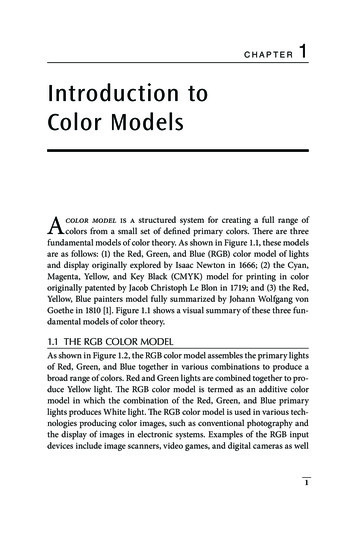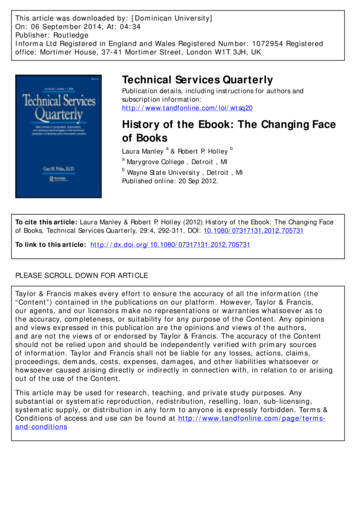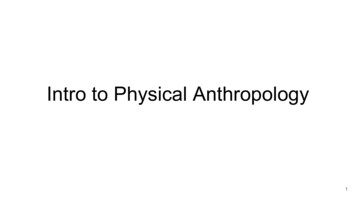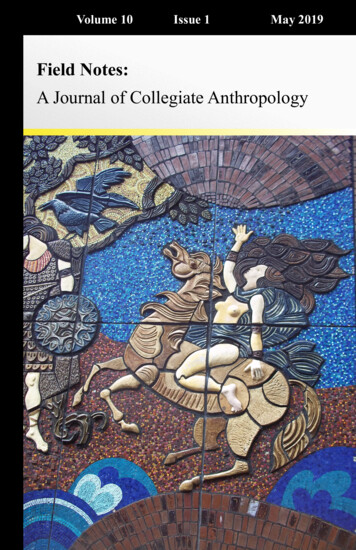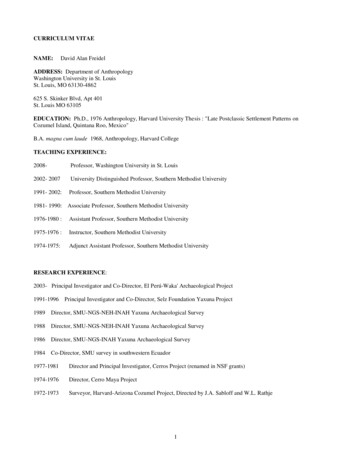
Transcription
COMPANION ENCYCLOPEDIAOF ANTHROPOLOGY
COMPANIONENCYCLOPEDIAOFANTHROPOLOGYEDITED BYTIM INGOLDLondon and New York
First published in 1994by Routledge11 New Fetter Lane, London EC4P 4EEThis edition published in the Taylor & Francis e-Library, 2003.Simultaneously published in the USA and Canadaby Routledge, Inc.29 West 35th Street, New York, NY 10001Structure and editorial matter 1994 Tim IngoldThe chapters 1994 RoutledgeAll rights reserved. No part of this book may be reprinted or reproduced or utilized inany form or by any electronic, mechanical or other means, now known or hereafterinvented, including photocopying and recording, or in any information storage orretrieval system, without permission in writing from the publishers.British Library Cataloguing in Publication DataA catalogue record for this book is available from the British Library.Library of Congress Cataloging-in-Publication DataA catalog record for this book is available on request.ISBN 0-203-03632-8 Master e-book ISBNISBN 0-203-19104-8 (Adobe eReader Format)ISBN 0-415-02137-5 (Print Edition)
CONTENTSPrefaceGeneral introductionTim IngoldThe contributorsixxiiixxiiiPART I: HUMANITY1. Introduction to humanityTim Ingold2. Humanity and animalityTim Ingold3. The evolution of early hominidsPhillip V.Tobias4. Human evolution: the last one million yearsClive Gamble5. The origins and evolution of languagePhilip Lieberman6. Tools and tool behaviourThomas Wynn7. Niche construction, evolution and cultureF.J.Odling-Smee8. Modes of subsistence: hunting and gathering to agricultureand pastoralismRoy Ellen9. The diet and nutrition of human populationsIgor de Garine10. Demographic expansion: causes and consequencesMark N.Cohen11. Disease and the destruction of indigenous populationsStephen J.KunitzPART II: CULTURE12. Introduction to cultureTim Ingold13143379108133162197226265297327329v
CONTENTS13.14.15.16.17.18.19.20.21.22.23.24.25.Why animals have neither culture nor historyDavid Premack and Ann James PremackSymbolism: the foundation of cultureMary LeCron FosterArtefacts and the meaning of thingsDaniel MillerTechnologyFrançois SigautSpatial organization and the built environmentAmos RapoportPerceptions of timeBarbara AdamAspects of literacyBrian V.Street and Niko BesnierMagic, religion and the rationality of beliefGilbert LewisMyth and metaphorJames F.WeinerRitual and performanceRichard SchechnerThe anthropology of artHoward MorphyMusic and danceAnthony SeegerThe politics of culture: ethnicity and nationalismAnthony D.SmithPART III: SOCIAL LIFE26. Introduction to social lifeTim Ingold27. Sociality among humans and non-human animalsR.I.M.Dunbar28. Rules and prohibitions: the form and content of humankinshipAlan Barnard29. Understanding sex and genderHenrietta L.Moore30. Socialization, enculturation and the development of personalidentityFitz John Porter Poole31. Social aspects of language useJean DeBernardi32. Work, the division of labour and co-operationSutti 37756783813831861891
CONTENTS33.34.35.36.37.38.Exchange and reciprocityC.A.GregoryPolitical domination and social evolutionTimothy EarleLaw and dispute processesSimon RobertsCollective violence and common securityRobert A.RubinsteinInequality and equalityAndré BéteilleThe nation state, colonial expansion and the contemporaryworld orderPeter WorsleyIndex911940962983101010401067vii
PREFACEThis volume started life on the initiative of Jonathan Price, at that timeReference Books Editor at Croom Helm. His idea was for an Encyclopedia ofHuman Society whose subject would span the disciplines of anthropology,sociology and archaeology. We first met to discuss the project in August 1986,and it was then that he charmed me into agreeing to become the volume’seditor. It has been a big job, to put it mildly. In hindsight, it seems to me that Imust have been mad to take it on at all, let alone single-handed. No doubt mymotives were in part honourable, since I was strongly committed to the idea ofanthropology as a bridging discipline, capable of spanning the many divisionsof the human sciences. I wanted to prove that the possibility of synthesisexisted not just as an ideal, but as something that could be realized in practice.No doubt, too, I was motivated by a certain vanity: if a synthesis was to be built,I wanted to be the one to build it, and to reap the credit! Seven years on, I amboth older and perhaps a little wiser—no less committed to the ideal ofsynthesis, but a great deal more aware of the complexities involved, and ratherless confident about my own abilities to bring it about.Following my initial meeting with Jonathan Price, over a year passed before Iwas able to begin serious work on the project, which we had decided to callHumanity, Culture and Social Life. In October 1987 I drew up a prospectus forthe entire volume, which included a complete list of forty articles, dividedbetween the three parts spelled out in the title, and a rough breakdown of thecontents for each. Then, during the first half of 1988, I set about recruitingauthors for each of the articles. Meanwhile, Croom Helm had been subsumedunder Routledge, from whose offices Jonathan continued to oversee the project.My original schedule had been for authors to write their first drafts during1989, allowing a further nine months for consultation and editorial comment,with a deadline for final versions of September 1990 and a projectedpublication date of April 1992. As always, things did not go entirely accordingto schedule, and I soon found that I was receiving final drafts of some articleswhile a pile of first drafts of others were awaiting editorial attention, and whilefor yet others I was still trying to fill the gaps in my list of contributors. To mygreat embarrassment, I found that I was quite unable to keep to my owndeadlines. The inexorable growth of other commitments meant that drafts,ix
PREFACEdutifully submitted by their authors at the appointed time, languished for manymonths—and in some cases for more than a year—before I could get to workon them. During the academic year 1990–1, pressures of teaching andadministration, coupled with my assumption of the Editorship of the journalMan, grew so heavy that progress on the project more or less ground to a halt,and my deadline for submitting the whole volume to the publishers—set for theend of April, 1991—passed quietly by with most of the articles still at the firstdraft stage.The project was rescued by my good fortune in securing one whole year andtwo subsequent terms of research leave from the University of Manchester.The first year (1991–2) was made possible in part by a grant from theUniversity of Manchester Research Support Fund, for which I acknowledgemy profound thanks. The two following terms were taken as sabbatical leave,and I should like to thank all my colleagues in the Manchester Department ofSocial Anthropology for covering my teaching and administrative duties in myabsence. Shortly before his departure from Routledge to join the staff atEdinburgh University Press, the ever-patient Jonathan Price was finallyrewarded for his forbearance. At noon on 14 October 1992, he arrived in myoffice to collect the entire, edited manuscript, and to carry it off to London. Ihad completed work on the manuscript only two hours before! But the editorialintroductions had still to be written, and it was not until well into the followingspring that they were eventually finished. Meanwhile, Mark Hendy was hard atwork on the Herculean task of sub-editing the whole volume, which hecompleted by the beginning of May. I owe him a debt of gratitude for hisefforts. Since Jonathan left for Edinburgh, responsibility for guiding thevolume through the press passed to Michelle Darraugh, who has beenwonderfully supportive, efficient and understanding. Most of all, however, thisbook belongs to Jonathan, without whom it would never have been conceived inthe first place, and whose unflagging enthusiasm kept the project on the railseven during the most difficult of times.Looking back, I am surprised how closely the book, in its final form,resembles the original plan drawn up so many years ago. Only four of theprojected articles have been lost, and the titles and ordering of the majorityhave been changed little, if at all. There have been a few changes in the list ofcontributors along the way: in particular, I should like to put on record the sadloss of John Blacking, who died before he could begin work on his projectedarticle, ‘Music and dance’; and I should also like to thank Anthony Seeger forstepping into the breach at very short notice. There have also been somechanges in the volume’s title. All along, I wanted it to be a book to be read, andnot merely consulted as a work of reference, and for that reason I was inclinedto relegate the phrase An Encyclopedia of Anthropology to the subtitle. In manyways, the book is more akin to what might conventionally be called a handbookor a reader, rather than an encyclopedia. Be that as it may, after muchdiscussion it was eventually decided to call it a Companion Encyclopedia, ax
PREFACEphrase which nicely combines the notion of encompassing a whole field ofknowledge with that of guiding and accompanying the reader in his or herjourney through it. The original working title, Humanity, Culture and SocialLife, accordingly became the volume’s subtitle.I would like to take this opportunity to extend my personal thanks to all themany contributors to this book. They have put up patiently with endless delays,and responded graciously to my many and sometimes inordinate editorialdemands. I have, moreover, learned a tremendous amount from workingthrough their articles. But for maintaining my sanity over all these years, mygreatest debt of gratitude is to my wife, Anna, and my children, Christopher,Nicholas and Jonathan. Their support has been magnificent, and it is notsomething that I shall ever be able to repay.Tim IngoldManchesterSeptember 1993xi
GENERAL INTRODUCTIONTHE SCOPE OF ANTHROPOLOGYAnthropologists study people. They do not study stars, rocks, plants or theweather. But whilst we may have little difficulty in separating out the field ofanthropological inquiry from those of astronomy, geology, botany ormeteorology, it is not so obvious how—if at all—anthropology may bedistinguished from the many other branches of the human sciences, all ofwhich could claim to be studying people in one way or another. Medicine isconcerned with the workings of the human body, psychology with those of themind; history studies people’s activities in the past, sociology their institutionalarrangements in the present, and so on. The list could be extended almostindefinitely. What, then, is the distinctively anthropological way of studyingpeople?Part of the difficulty we have in answering this question is attributable to thefact that there is not one way of doing anthropology, but many. There are twofacets to this diversity, the first having to do with the circumstances of thediscipline’s historical development, the second lying in its contemporarysubdisciplinary divisions. I begin with a few words about anthropology’shistory.In a sense, of course, anthropology can be traced to the earliest antiquity,when human beings first began to speculate about their own nature, origins anddiversity. But as an explicitly defined field of academic inquiry, it is a creatureof the last two centuries of thought in that region of the world conventionallyknown as ‘the West’. Western thought, however, is not a monolithic edifice but acomplex interweaving of often opposing currents, and this is no less true of thecareer of anthropology. Moreover, these currents did not flow in an historicalvacuum, but at every moment responded to dominant moral, political andeconomic concerns of the time. Thus British anthropology developed alongsidethe growth of empire; its preoccupations were fuelled by the need of thecolonial administration to take the measure of its presumed superiority overadministered nations, and to turn a knowledge of their social organizations andcultural traditions to the service of indirect rule. In many countries ofContinental Europe, by contrast, the growth of anthropology (more commonlyxiii
GENERAL INTRODUCTIONknown as ‘ethnology’) was linked to emergent nationalist movements of the latenineteenth and early twentieth centuries, and to the efforts, on the part ofadherents of each movement, to discover a national heritage in the traditions oflocal folk or peasant culture. In North America the situation was differentagain: the United States and Canada had their indigenous Indian populations,and the first priority of many American anthropologists was to record as muchas possible about the physical features, material artefacts, languages andcultures of extant Amerindian groups before it was too late. This was a kind ofsalvage anthropology.The second facet to the diversity of anthropological approaches lies in thefact that anthropology, as it exists today, is not a single field, but is rather asomewhat contingent and unstable amalgam of subfields, each encumberedwith its own history, theoretical agenda and methodological preoccupations. Inthe American tradition of scholarship, it has long been customary todistinguish four such subfields of anthropology, namely physical,archaeological, cultural and linguistic. In the British tradition, by contrast,there are only three subfields, of physical anthropology, archaeology and social(rather than cultural) anthropology. The exclusion of linguistics from Britishanthropology is a curious and somewhat scandalous anomaly to which I returnbelow. The more immediate question is: why these fields in particular? Whatbrought the study of physical types, ancient artefacts and supposedly‘primitive’ ways of life under the umbrella of a single discipline ofanthropology?Most academic disciplines and their bo
Reference Books Editor at Croom Helm. His idea was for an Encyclopedia of Human Society whose subject would span the disciplines of anthropology, sociology and archaeology. We first met to discuss the project in August 1986, and it was then that he charmed me into agreeing to become the volume’s editor. It has been a big job, to put it mildly .


